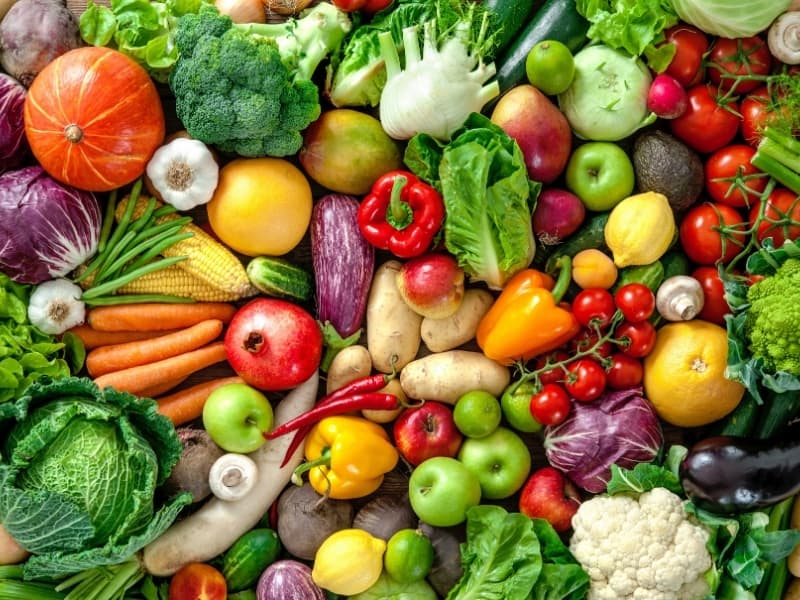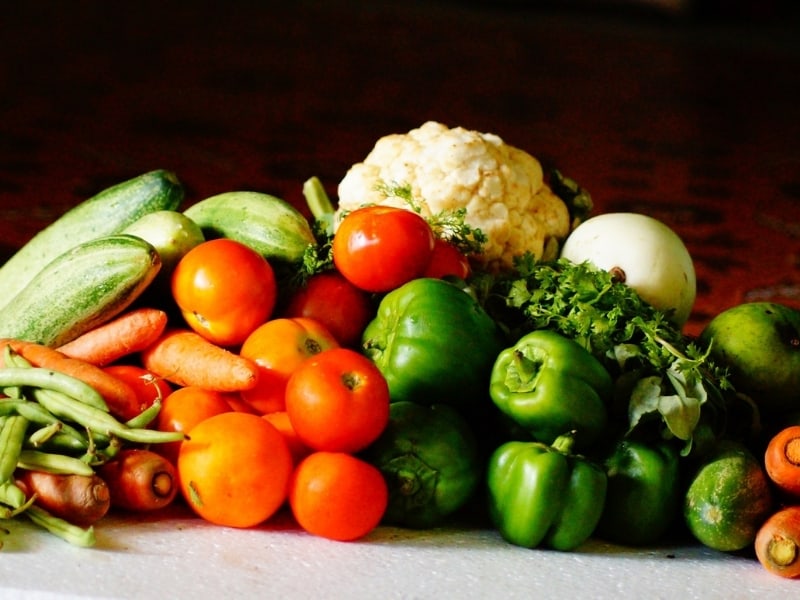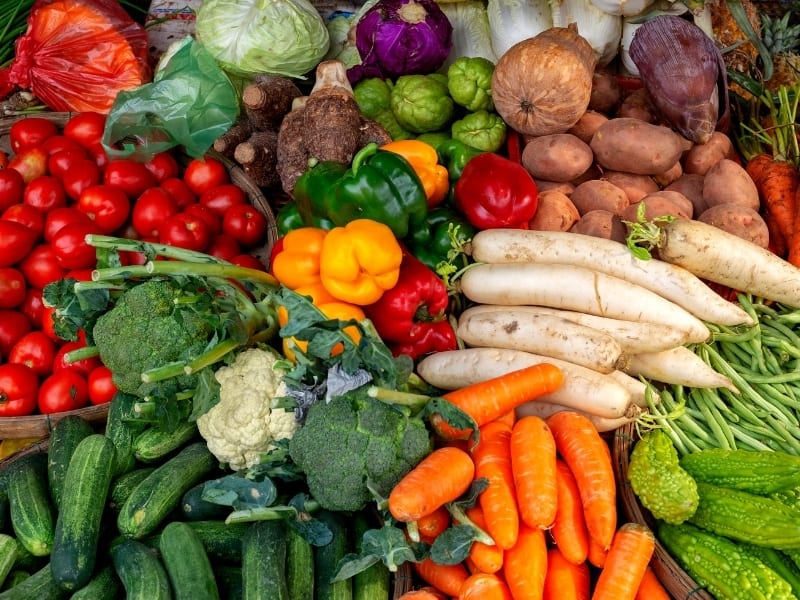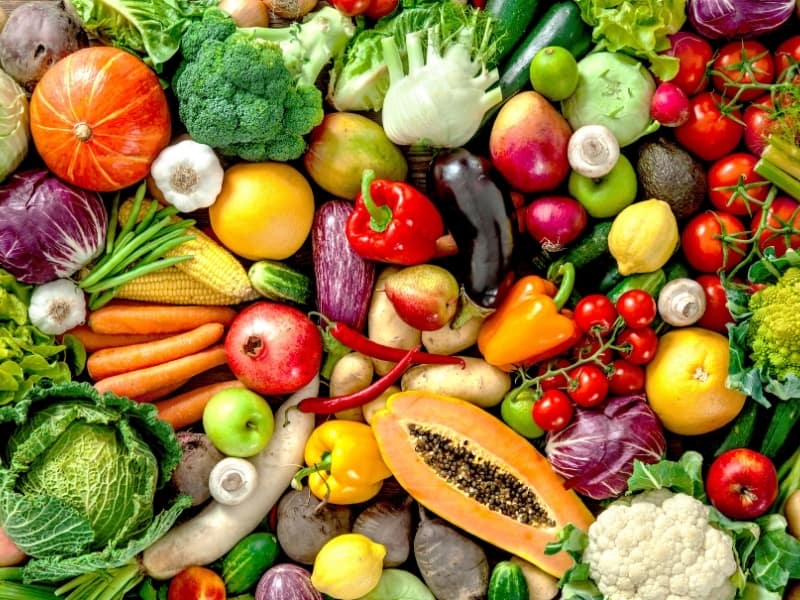
Colorful and nutritious, vegetables are one of the healthiest foods you can eat. Veggies are also very versatile, and depending on a type they can be used fresh for salads or cooked in many different ways.
There are many different types of vegetables and they are often classified based on their edible parts that are used for culinary purposes. However, some veggies can fall into several categories when various parts of the plant are edible.
In this article, we’ll list different types of vegetables sold at grocery stores and farmer’s markets. You’ll also learn about vegetable groups and find a list of 55 popular types of vegetables.
How Many Varieties of Vegetables Are There?
A recent study by Biodiversity International scientists identified a total of 1097 vegetable species cultivated worldwide. Furthermore, there are thousands of different varieties of vegetables with many different uses and growth forms.
Despite the great diversity of vegetables, it’s estimated that we are familiar with less than seven percent of all vegetable species. In fact, most people base their diets primarily on commercial vegetables such as tomatoes, potatoes, onions, and carrots.
What Are The 8 Types of Vegetables?

Vegetables can be classified in many ways. So you’ll likely hear about different classifications, groups, and types of vegetables depending on who you’re talking to.
Most commonly, vegetables are grouped into eight main types based on their edible parts.
Flower vegetables
Flower vegetables are plants that produce flowers that are commonly used for culinary purposes. In most cases, flower vegetables are seasonal and primarily grown for their flower buds.
While these vegetables have roots, leaves, and stems, their flowers are usually the only edible part of the plant. Cauliflower, broccoli, artichoke, caper, and loroco are the most commonly consumed vegetable flowers.
Leafy vegetables
Also known as greens, salad greens, or vegetable greens, leafy vegetables are a good source of valuable nutrients. They can be eaten raw or cooked and are mainly grown for their leafy parts.
The best examples of leafy vegetables are spinach, cabbage, lettuce, bok choy, Brussels sprouts, kale, chard, and watercress.
Tuber vegetables
Veggies that grow underground on the root of a plant are known as tuber vegetables. Tuberous vegetables are usually high in starch and are used as a staple food in many parts of the world.
The most commonly consumed tuber vegetables are potato, cassava, sweet potato, kumara, yam, taro, Jerusalem artichoke, and ulluco.
Root vegetables
Vegetables that generally grow underground and are sources of edible roots are classified as root vegetables. These veggies are full of valuable nutrients and also contain carbs, starches, and sugar.
Depending on the type, a root vegetable can have a round or long shape and a fleshy texture. Carrot, radish, turnip, beet, horseradish, celery, turmeric, and parsnips are the most commonly consumed root vegetables.
Bulb vegetables
Plants that grow just below the ground and produce edible bulbs are classified as bulb vegetables. Intensely aromatic, bulbs usually have many layers, and depending on the type can be eaten raw or used to add flavor to cooked dishes.
Some of the most commonly used bulbs are onion, shallot, garlic, leek, spring onion, scallion, and fennel.
Stem vegetables
Plants that grow above ground and have edible stems fall under stem vegetables. There are also modified stems that can be found above and below ground, such as corms, rhizomes, and tubers.
Asparagus, celery, chard, fennel, fiddlehead, cardoon, and bamboo shoots and the most popular stem vegetables.
Fruit vegetables
Fruit vegetables are certain types of plants that are botanically classified as fruits but are used as vegetables for culinary purposes. You’ll be surprised to learn that some produce you call fruits are actually vegetables and vice versa.
Tomatoes, cucumbers, and eggplants are probably the most popular and commonly consumed types of fruit vegetables. Additionally, squash, avocado, bitter melon, and bell pepper are also good examples of fruit vegetables.
Pod and seed vegetables
Podded vegetables, popularly known as legumes are types of vegetables that contain seeds inside a pod. These vegetables are a good source of protein and fiber, and also contain valuable minerals.
The most popular podded vegetables are peas, beans, lentils, okra, chickpea, peanut, soybean, and licorice.
What Are The 5 Groups of Vegetables?

Any type of vegetable or a 100% natural vegetable juice falls into the Vegetable Group. Furthermore, all vegetables are divided into five subgroups based on their nutritional profile.
Knowing more about the Vegetable Group can help you understand what are the recommended daily and weekly amounts of vegetables you need to consume.
Note, the exact amount of vegetables you need to eat depends on your individual needs and can vary between one to three cups each day.
Vegetables are organized into the following five groups:
Starchy Vegetables
All veggies are grouped into two main categories, starchy and non-starchy vegetables. Both starchy and non-starchy vegetables have a great nutritional profile, however, starchy vegetables have more carbs and calories.
While many people avoid eating them altogether, starchy vegetables are full of valuable nutrients and should be a part of a balanced diet. Potatoes, sweet corn, green peas, green lima beans, and field peas are the most popular types of starchy vegetables.
Red and Orange Vegetables
Chock full of beneficial nutrients and vitamins, red and orange vegetables can increase your overall health and keep you energized. These veggies are full of carotenoids which give them their orange and red color, and also reduce the risk of cataracts and other age-related eye problems.
Vegetables in this group contain significant levels of vitamins A, C, K, and potassium among other valuable nutrients. Some of the most popular red and orange vegetables are carrots, sweet potatoes, tomatoes, pumpkins, winter squash, red and orange sweet peppers.
Beans and Peas
Available in dry, frozen, and canned forms, beans and peas are excellent sources of plant protein and as such a great vegetarian alternative for meat. They are full of dietary fiber and contain valuable nutrients such as iron, zinc, and potassium.
Kidney beans, pinto beans, black beans, lima beans, lentils, split peas, soybeans, and navy beans are the most popular types of beans and peas.
Dark-Green Vegetables
Dark-green vegetables are an excellent source of fiber, folate, and carotenoids, but are at the same time low in calories. As high fiber foods, these veggies promote bowel movement and help control blood sugar levels.
Popular dark green vegetables are bok choy, kale, broccoli, collard greens, spinach, all lettuces, mustard greens, and turnip greens.
Other Vegetables
The other vegetable group is slightly different and consists of veggies that don’t fit into any other category. Since this group is so diverse, we can’t pinpoint the exact nutrients, but it’s safe to say that these veggies contain fiber and a variety of vitamins and minerals.
Some of the most popular other vegetables are asparagus, Brussel sprouts, cauliflower, cucumber, eggplant, beets, cabbage, celery, okra, and zucchini.
55 Popular Types of Vegetables

Healthy and nutritious, vegetables come in many forms and can be cooked or eaten raw and used in many different recipes. Listed below are the most popular types of vegetables that deserve a place on your plate:
- Eggplant
- Mushroom
- Brussels sprout
- Garlic
- Snap pea
- Carrot
- Collard greens
- Leek
- Pinto Beans
- Corn
- Potato
- Romaine lettuce
- Broccoli
- Chives
- Iceberg Lettuce
- Olives
- Zucchini
- Baby Carrot
- Avocado
- Yam
- Asparagus
- Lettuce
- Spring Onions
- Jalapeño
- Lima Bean
- Cauliflower
- Sweet corn
- Celery is listed
- Cucumber
- Cabbage
- Okra
- Beet
- Habanero chili
- Kale
- Onion
- Red bell pepper
- Yellow Bell pepper
- Spinach
- Black Beans
- Green Bell pepper
- Heirloom Tomato
- Arugula
- Cayenne pepper
- Radish
- Artichoke
- Pea is listed
- Squash
- Red cabbage
- Red onion
- Chili pepper
- Sweet potato
- Ginger
- Rhubarb
- Green bean
- Pumpkin
What Is the Healthiest Vegetable?
All vegetables are good for your health and you can’t go wrong no matter which one you choose. However, thanks to its nutrient-packed profile, spinach tops the charts as one of the healthiest vegetables.
Just one serving of spinach accounts for more than half of your daily vitamin A needs and is also a good source of vitamin K, magnesium, folate, and antioxidants. Spinach is also high in beta carotene and lutein which can reduce the risk of cancer.
Conclusion
Healthy and nutritious, vegetables should be an integral part of your daily diet. Naturally filling and chock full of vitamins and minerals, veggies can keep you energized and healthy.
There are many different types of vegetables and they are usually grouped based on the edible part of the plant. However, some vegetables can fit into several groups, beetroot has edible roots and leaves and is at the same time a leafy and root vegetable.
Now that you know what are different types of vegetables you’ll be able to plan your meals better and experience all the benefits veggies have to offer.
Related Contents:

